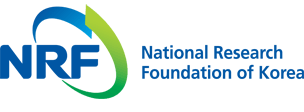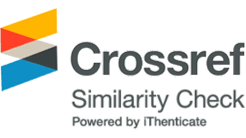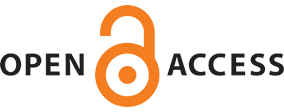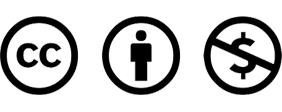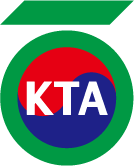Research Paper
ACI Committee 318 (1995), Building code requirements for structural concrete (ACI 318-95) and commentary (ACI 318R-95), American Concrete Institute, Farmington Hills, MI, pp. 1417-1424.
Aldrian, W., Bantle, A., Juhart, J. (2022), "CO2 reduction in tunnel construction from a material technology point of view", Geomechanics and Tunnelling, Vol. 15, No. 6, pp. 799-810.
10.1002/geot.202200036Amran, Y.H.M., Soto, M.G., Alyousef, R., El-Zeadani, M., Alabduljabbar, H., Aune, V. (2020), "Performance investigation of high-proportion Saudi-fly-ash-based concrete", Results in Engineering, Vol. 6, 100118.
10.1016/j.rineng.2020.100118Atkinson, J.H., Mair, R.J. (1981), Soil mechanics aspects of soft ground tunnelling, Ground Engineering, Vol. 14, No. 5, pp. 20-26.
CEN (European Committee for Standardization) (2010), Eurocode 2: Design of concrete structures-Part 1-1: General rules and rules for buildings, European Union, Brussels, Belgium, p. 225.
Hammond, G., Jones, C., Lowrie, F., Tse, P. (2011), Embodied carbon, The Inventory of Carbon and Energy (ICE), Version (2.0), pp. 5.
Huntzinger, D.N., Eatmon, T.D. (2009), "A life-cycle assessment of Portland cement manufacturing: Comparing the traditional process with alternative technologies", Journal of Cleaner Production, Vol. 17, No. 7, pp. 668-675.
10.1016/j.jclepro.2008.04.007Jeon, S.S., Jang, Y.W. (2009), "Numerical analysis of concrete lining and rockbolt behavior of the tunnel associated with blast-induced vibration", Journal of the Korean Society of Hazard Mitigation, Vol. 9, No. 5, pp. 69-78.
KEITI (Korea Environmental Industry and Technology Institute) Home page, LCI DB, https://ecosq.or.kr/websquare.do#w2xPath=/ui/cer/ic/oh/ICOH110M01.xml&valVl=tabs3&menuSn=20018500 (January 8, 2025).
KICT (Korea Institute of Civil Engineering and Building Technology) (2015), Revision of eco-friendly concrete standards: A study on the revision of low carbon type concrete standards, pp. 113-114.
KTA (Korean Tunneling and Underground Space Association) (2018), Tunnel standard specifications, CIR, Seoul, pp. 35-57.
10.979.115610/1086McKinsey & Company, Call for action: Seizing the decarbonization opportunity in construction, https://www.mckinsey.com/industries/engineering-construction-and-building-materials/our-insights/call-for-action-seizing-the-decarbonization-opportunity-in-construction (January 8, 2025).
MOLIT (Ministry of Land, Infrastructure and Transport) (2021), Practical design guidelines for national highway construction, pp. 300-301.
10.978.8992312/356Nukah, P.D., Abbey, S.J., Booth, C.A., Oti, J. (2024), "Development of low carbon concrete and prospective of geopolymer concrete using lightweight coarse aggregate and cement replacement materials", Construction and Building Materials, Vol. 428, 136295.
10.1016/j.conbuildmat.2024.136295Oner, A., Akyuz, S. (2007), "An experimental study on optimum usage of GGBS for the compressive strength of concrete", Cement and Concrete Composites, Vol. 29, No. 6, pp. 505-514.
10.1016/j.cemconcomp.2007.01.001Sauer, J. (2016), Ecological considerations on the sustainability of tunnel structures in transport infrastructure, Doctoral Dissertation, Technical University of Munich, pp. 44.
Seo, Y.S., Yun, H.S., Kim, D.G., Kwon, O.I. (2016), "Analysis on physical and mechanical properties of rock mass in Korea", The Journal of Engineering Geology, Vol. 26, No. 4, pp. 593-600.
10.9720/kseg.2016.4.593Suresh, D., Nagaraju, K. (2015), "Ground granulated blast slag (GGBS) in concrete - A review", IOSR Journal of Mechanical and Civil Engineering, Vol. 12, No. 4, pp. 76-82.
10.9790/1684-12467682- Publisher :Korean Tunneling and Underground Space Association
- Publisher(Ko) :한국터널지하공간학회
- Journal Title :Journal of Korean Tunnelling and Underground Space Association
- Journal Title(Ko) :한국터널지하공간학회 논문집
- Volume : 27
- No :2
- Pages :115-134
- Received Date : 2025-02-07
- Revised Date : 2025-02-25
- Accepted Date : 2025-02-25
- DOI :https://doi.org/10.9711/KTAJ.2025.27.2.115
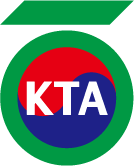



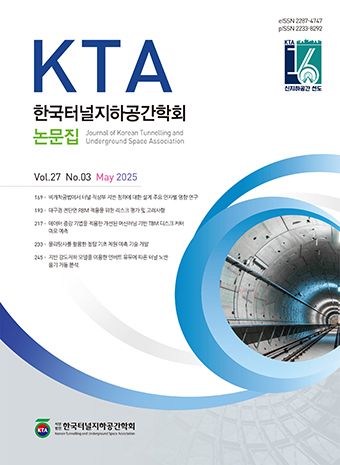 Journal of Korean Tunnelling and Underground Space Association
Journal of Korean Tunnelling and Underground Space Association
